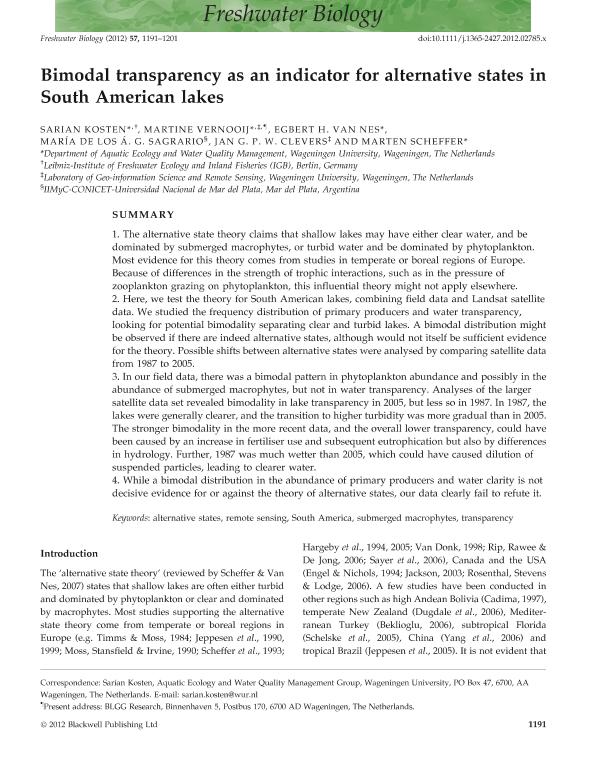Mostrar el registro sencillo del ítem
dc.contributor.author
Kosten, Sarian
dc.contributor.author
Vernooij, Martine
dc.contributor.author
Van Nes, Egbert H.
dc.contributor.author
Gonzalez Sagrario, Maria de Los Angeles

dc.contributor.author
Clevers, Jan G.P.W.
dc.contributor.author
Scheffer, Marten
dc.date.available
2019-03-18T17:38:03Z
dc.date.issued
2012-06
dc.identifier.citation
Kosten, Sarian; Vernooij, Martine; Van Nes, Egbert H.; Gonzalez Sagrario, Maria de Los Angeles; Clevers, Jan G.P.W.; et al.; Bimodal transparency as an indicator for alternative states in South American lakes; Wiley Blackwell Publishing, Inc; Freshwater Biology (print); 57; 6; 6-2012; 1191-1201
dc.identifier.issn
0046-5070
dc.identifier.uri
http://hdl.handle.net/11336/71873
dc.description.abstract
1.The alternative state theory claims that shallow lakes may have either clear water, and be dominated by submerged macrophytes, or turbid water and be dominated by phytoplankton. Most evidence for this theory comes from studies in temperate or boreal regions of Europe. Because of differences in the strength of trophic interactions, such as in the pressure of zooplankton grazing on phytoplankton, this influential theory might not apply elsewhere. 2.Here, we test the theory for South American lakes, combining field data and Landsat satellite data. We studied the frequency distribution of primary producers and water transparency, looking for potential bimodality separating clear and turbid lakes. A bimodal distribution might be observed if there are indeed alternative states, although would not itself be sufficient evidence for the theory. Possible shifts between alternative states were analysed by comparing satellite data from 1987 to 2005. 3.In our field data, there was a bimodal pattern in phytoplankton abundance and possibly in the abundance of submerged macrophytes, but not in water transparency. Analyses of the larger satellite data set revealed bimodality in lake transparency in 2005, but less so in 1987. In 1987, the lakes were generally clearer, and the transition to higher turbidity was more gradual than in 2005. The stronger bimodality in the more recent data, and the overall lower transparency, could have been caused by an increase in fertiliser use and subsequent eutrophication but also by differences in hydrology. Further, 1987 was much wetter than 2005, which could have caused dilution of suspended particles, leading to clearer water. 4.While a bimodal distribution in the abundance of primary producers and water clarity is not decisive evidence for or against the theory of alternative states, our data clearly fail to refute it. © 2012 Blackwell Publishing Ltd.
dc.format
application/pdf
dc.language.iso
eng
dc.publisher
Wiley Blackwell Publishing, Inc

dc.rights
info:eu-repo/semantics/openAccess
dc.rights.uri
https://creativecommons.org/licenses/by-nc-sa/2.5/ar/
dc.subject
Alternative States
dc.subject
Remote Sensing
dc.subject
South America
dc.subject
Submerged Macrophytes
dc.subject
Transparency
dc.subject.classification
Otras Ciencias Biológicas

dc.subject.classification
Ciencias Biológicas

dc.subject.classification
CIENCIAS NATURALES Y EXACTAS

dc.title
Bimodal transparency as an indicator for alternative states in South American lakes
dc.type
info:eu-repo/semantics/article
dc.type
info:ar-repo/semantics/artículo
dc.type
info:eu-repo/semantics/publishedVersion
dc.date.updated
2019-03-08T16:44:38Z
dc.journal.volume
57
dc.journal.number
6
dc.journal.pagination
1191-1201
dc.journal.pais
Reino Unido

dc.journal.ciudad
Londres
dc.description.fil
Fil: Kosten, Sarian. Wageningen University; Países Bajos. Leibniz-Institute of Freshwater Ecology and Inland Fisheries; Alemania
dc.description.fil
Fil: Vernooij, Martine. Wageningen University; Países Bajos
dc.description.fil
Fil: Van Nes, Egbert H.. Wageningen University; Países Bajos
dc.description.fil
Fil: Gonzalez Sagrario, Maria de Los Angeles. Consejo Nacional de Investigaciones Científicas y Técnicas. Centro Científico Tecnológico Conicet - Mar del Plata. Instituto de Investigaciones Marinas y Costeras. Universidad Nacional de Mar del Plata. Facultad de Ciencias Exactas y Naturales. Instituto de Investigaciones Marinas y Costeras; Argentina
dc.description.fil
Fil: Clevers, Jan G.P.W.. Wageningen University; Países Bajos
dc.description.fil
Fil: Scheffer, Marten. Wageningen University; Países Bajos
dc.journal.title
Freshwater Biology (print)

dc.relation.alternativeid
info:eu-repo/semantics/altIdentifier/doi/https://dx.doi.org/10.1111/j.1365-2427.2012.02785.x
dc.relation.alternativeid
info:eu-repo/semantics/altIdentifier/url/https://onlinelibrary.wiley.com/doi/abs/10.1111/j.1365-2427.2012.02785.x
Archivos asociados
